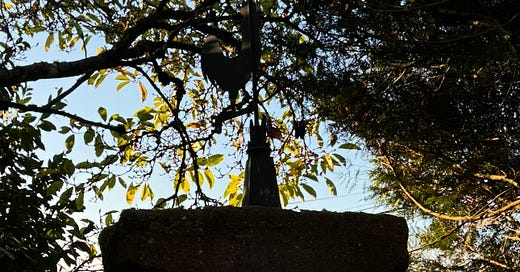How I Bought a House Built in 1647 Without Ever Stepping Inside (Because…France)
My key to a future I did not plan.
Some people fall in love with houses after seeing a beautifully staged living room. I fell in love through a window, while my Immobilier (French realtor) cursed at a lockbox and I contemplated ordering duck confit just to kill time.
I bought the house anyway.
Welcome to how I became the proud, possibly unhinged owner of a crumbling 1647 estate in rural France.
Act I: The Search (a.k.a. The Spreadsheet of Insanity)
In my previous life—the one with income, structure, and reasonably functioning WiFi—I had a holiday home in the Dordogne. It was dreamy. We split our time between the hustle of Seattle and the slow-bubbling cassoulet pace of rural France.
But when I blew up my life and set out on my Mamma Mia adventure (minus the singing but with more paperwork), I told myself I needed something new.
Except I didn’t. What I needed was a French farmhouse, some ducks, and a fantasy that included a gîte, a pool, and somewhere to park the entire contents of a 20-foot shipping container currently sweating in a warehouse in Málaga.
I flew up from Spain twice with a real estate spreadsheet the size of a medieval scroll. My requirements:
• Total privacy
• Room for guests
•Room for my vintage cookbook collection
•Room for my American delusions about laundry rooms
•Oh, and a kitchen big enough to host either a dinner party or a low-grade identity crisis
Act II: The Drive-By Purchase
I came close on purchasing House #21. It was a pretty, private place in a village. I decided that if the next and last house I was to see that day didn’t work out, I’d buy it.
Enter: House #22. We arrived. The realtor forgot the code to the lockbox. Yes, a strong start.
He suggested lunch while he figured it out. And since this is France, that meant two hours, three courses, two carafes of wine (red and white—what, no rosé?), and exactly zero lockbox progress.
We returned, still no code.
I walked around the outside. Peeked in some windows. Saw old shutters, crumbly stone, slanted slate, and a tree that looked like it judged everyone who’d ever owned a leaf blower.
“I’ll take it,” I said.
“You haven’t even seen the inside,” the agent replied, horrified.
“I can change the inside. I can’t change the outside.”
And that was it. I had just bought a house built in 1647—with a pool, a gîte (former Pig Barn), and all the extras no one mentions in the listings: dust, bees, critters, mold, and the kind of plumbing that makes you believe in past lives.
Act III: The Notaire, the Wires, and the Wire Transfers
French property law is what happens when bureaucracy drinks Pastis and forgets what it was doing.
First, I learned that you can only wire €30,000 per day due to anti-money laundering laws. This meant multiple wires over multiple days. Which - stay with me - feels more suspicious, but apparently is less.
Then came the agriculture clause, the pre-sale rights, the ancient peasant law footnotes. Eventually, I paid the notaire an “acceleration fee” of €300 to get the papers moving. Was it a bribe?
Let’s call it a merci.
Act IV: The Key, the Gîte, and the Grit
The day I finally “moved in,” the house wasn’t ready to be habitable. I hadn’t even laid eyes on the inside yet. The container was still in Málaga so I moved into the gîte.
By “moved in,” I mean:
• I couldn't get the front door open.
• The previous owners took everything, including the light bulbs, the switch plates, and most of the decorum.
• And the first night, the gas bottle for the stove ran out. Yes, no sewer line, no gas line. I sat on the cold tile floor, wondering what on earth I had done.
Then I found a YouTube video on how to change a gas bottle, did it myself, and officially entered the French Expat Pioneer Woman phase of my life.
Within days:
• Mice had chewed through the gîte’s electrical wires.
• A mystery leak appeared in the ceiling. It was not water. It was a fouine—a “stone marten” (read: feral weasel gremlin) urinating so frequently in the attic crawlspace that it soaked through the plaster.
• My new key looked like a 17th-century prison prop and, fun fact: all skeleton keys in France are basically interchangeable.
Security by obscurity.
And then—lightning struck a fence. Which jumped to a tree. Which fell into the pool.
Sidebar (and Spoiler Alert): At that time, I didn’t know a two-ton cow would one day follow it.
Closing
So yes, I bought a 1647 house in rural France without ever stepping inside. I had no furniture (well, I did but it was in another European country), no electricity, and a weasel urinating on my ceiling.
But I also had a dream, a key, and a pool filled with branches and foreshadowing.
It wasn’t the life I expected. But it was mine. And honestly?
I was just getting started.
Want to know what happened when the container finally arrived?
It involved mold, missing tables, and one lonely Prada shoe.
Subscribe to be sure to read Part Two.




I love the open admittance with our laundry obsession 😂! But more importantly: your dedication to the vintage book collection.
This is exactly how I don’t want but probably will end up experiencing my eventual expat journey! I’ll be lucky to have a house soaked in weasel piss. With a writer’s eye and the magic of the countryside truly anything is possible. What a treat to read.